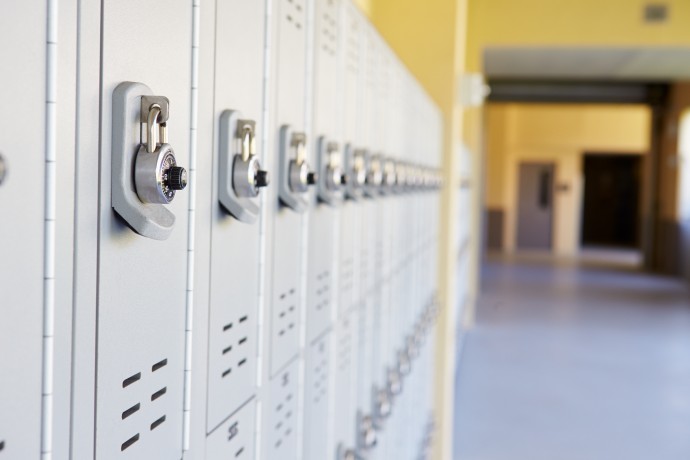School violence occurs on school property, on the way to or from school or a school-sponsored event, or during a school-sponsored event. Keeping our children safe and preventing violence in school is a top priority for parents, school administrators and lawmakers.
According to the U.S. Department of Education, in 2013, about 65% of schools reported violent incidents on public school campuses. And the National Center for Missing & Exploited Children reports there are over 800,000 registered sex offenders in the United States.
These and other safety risks are top of mind for all parents as they send their children off to school each day.
However, there are no easy or clear solutions to establishing a safe school environment, without students and teachers feeling like they’re in a prison.
At Catalyst Circle Rock School in Chicago, Ill. they practice lock down drills. School personnel is responsible for monitoring an assigned part of the building, while the teachers are responsible for the safety of each student in their classroom. The drill enables them to demonstrate what to do in a lockdown scenario and to practice keeping students calm in the event of an actual threat.
Many schools have cameras inside and outside the school building to monitor activity going in and out of the building. Ronald D. Stephens, executive director of the National School Safety Center, shared in a Scholastic article that the use of school cameras “has to be a decision that is well thought through and that involves students, parents and the community.”
Stephens—who is also a former teacher and assistant superintendent—says he understands that high-profile school violence often makes cameras much more appealing. “People want to do something after a crisis, and sometimes they pick the thing that is tangible, visible and easy to measure,” he says.
Bob Stockwell, chief technology officer for Stanley Security Solutions, says that cameras are part of basic security measures, because they help gather evidence after an event. “[Cameras] are good because they may frighten people off from doing something if they see cameras, but they really are a tool for post-event evidence,” he says.
Although the 2014 report, Indicators of School Crime and Safety, by the National Center for Education Statistics, found that acts of physical violence in schools resulting in death are relatively rare, many students experience nonfatal acts of passive and physical school violence. In 2013:
- Among students ages 12–18, there were about 1.4 million nonfatal victimizations at school, which include theft, simple assault and serious violent acts.
- Students ages 12–18 experienced higher rates of nonfatal victimizations at school than away from school. They experienced 55 victimizations per 1,000 students at school and 30 per 1,000 students away from school.
Stockwell also says creating solid school security procedures should be a layered approach of technology and administration. And parents can also be a part of the process. “The idea is you want to make it as invisible to the students as possible,” he says. “But at the same token, you want the administrative staff to be involved and you want the parents to buy in on what you’re doing.”
Patrick V. Fiel Sr., former executive director of security for the Washington DC Public Schools offers a few safety tips for families and school administrators:
- Parents who are actively involved in their student’s school security can improve their child’s safety and success on campus. Bullying, gangs, drug sales, weapons and sex predators are on the streets every day. If your child walks or rides a bicycle to school, choose the safest possible route with the fewest street crossings. Children should walk in groups and be
supervised.
- Corroborate there is at least one parent with children waiting at a school bus stop. This is a time when potentially risky activity, such as bullying and fighting, can occur.
- Educate yourself about school safety and security. Talk to your children about their safety concerns and visit their campus to talk with an administrator about the school’s emergency/crisis plans. I would recommend that a School Resource Officer (SRO) be assigned to each school.
- All schools should have a safety/security committee. Parents should become members to voice their concerns and opinions.
- All schools, especially elementary schools, must implement a closed campus policy. The main campus entrance should be controlled using electronic access through a video intercom system. If a parent can walk into a school unchallenged, so can unwanted visitors. All other doors should be locked throughout the day.
- Once a visitor is approved to enter, he or she must check in at the office.A government-issued identification should be presented to be screened before a temporary badge is printed for the person to wear at all times while on campus.
- Check to see if the campus has cameras that monitor entries, hallways and common and outside areas.
- If students are alone in the afternoons, teach them to go straight home, keep doors locked, and not answer the door for anyone.
- Do not keep firearms easily accessible in your home and talk to kids about the potential dangers of guns. If you do have a gun in the house, it is vital to keep it unloaded, locked with the ammunition stored separately, and to check weapons periodically.
According to a report by the Center for Disease Control, a nationally representative sample of youth in grades 9-12 found that
in 2013:
- 8.1% reported being in a physical fight on school property in the 12 months before the survey.
- 7.1% reported that they did not go to school on one or more days in the 30 days before the survey because they felt unsafe at school or on their way to or from school.
- 5.2% reported carrying a weapon (gun, knife or club) on school property on one or more days in the 30 days before the survey.
- 6.9% reported being threatened or injured with a weapon on school property one or more times in the 12 months before the survey.
- 19.6% reported being bullied on school property and 14.8% reported being bullied electronically during the 12 months before the survey.
Shaina Croom is the editorial specialist at National PTA and managing editor of Our Children Magazine. Kisha DeSandies Lester also contributed to the article.





